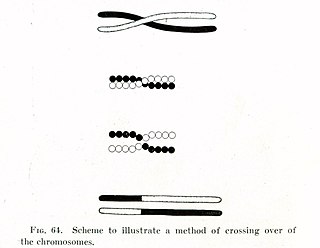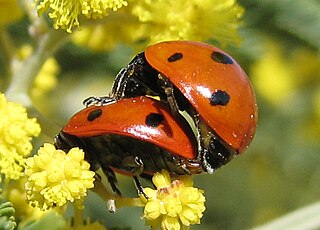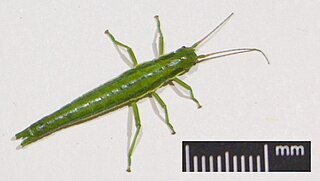Related Research Articles

Asexual reproduction is a type of reproduction that does not involve the fusion of gametes or change in the number of chromosomes. The offspring that arise by asexual reproduction from either unicellular or multicellular organisms inherit the full set of genes of their single parent and thus the newly created individual is genetically and physically similar to the parent or an exact clone of the parent. Asexual reproduction is the primary form of reproduction for single-celled organisms such as archaea and bacteria. Many eukaryotic organisms including plants, animals, and fungi can also reproduce asexually. In vertebrates, the most common form of asexual reproduction is parthenogenesis, which is typically used as an alternative to sexual reproduction in times when reproductive opportunities are limited. Some monitor lizards, including Komodo dragons, can reproduce asexually.
Population genetics is a subfield of genetics that deals with genetic differences within and among populations, and is a part of evolutionary biology. Studies in this branch of biology examine such phenomena as adaptation, speciation, and population structure.

In evolutionary genetics, Muller's ratchet is a process which, in the absence of recombination, results in an accumulation of irreversible deleterious mutations. This happens because in the absence of recombination, and assuming reverse mutations are rare, offspring bear at least as much mutational load as their parents. Muller proposed this mechanism as one reason why sexual reproduction may be favored over asexual reproduction, as sexual organisms benefit from recombination and consequent elimination of deleterious mutations. The negative effect of accumulating irreversible deleterious mutations may not be prevalent in organisms which, while they reproduce asexually, also undergo other forms of recombination. This effect has also been observed in those regions of the genomes of sexual organisms that do not undergo recombination.
In evolutionary genetics, mutational meltdown is a sub class of extinction vortex in which the environment and genetic predisposition mutually reinforce each other. Mutational meltdown is the accumulation of harmful mutations in a small population, which leads to loss of fitness and decline of the population size, which may lead to further accumulation of deleterious mutations due to fixation by genetic drift.

Evolution of sexual reproduction describes how sexually reproducing animals, plants, fungi and protists could have evolved from a common ancestor that was a single-celled eukaryotic species. Sexual reproduction is widespread in eukaryotes, though a few eukaryotic species have secondarily lost the ability to reproduce sexually, such as Bdelloidea, and some plants and animals routinely reproduce asexually without entirely having lost sex. The evolution of sexual reproduction contains two related yet distinct themes: its origin and its maintenance. Bacteria and Archaea (prokaryotes) have processes that can transfer DNA from one cell to another, but it is unclear if these processes are evolutionarily related to sexual reproduction in Eukaryotes. In eukaryotes, true sexual reproduction by meiosis and cell fusion is thought to have arisen in the last eukaryotic common ancestor, possibly via several processes of varying success, and then to have persisted.
Evolvability is defined as the capacity of a system for adaptive evolution. Evolvability is the ability of a population of organisms to not merely generate genetic diversity, but to generate adaptive genetic diversity, and thereby evolve through natural selection.
Genetic load is the difference between the fitness of an average genotype in a population and the fitness of some reference genotype, which may be either the best present in a population, or may be the theoretically optimal genotype. The average individual taken from a population with a low genetic load will generally, when grown in the same conditions, have more surviving offspring than the average individual from a population with a high genetic load. Genetic load can also be seen as reduced fitness at the population level compared to what the population would have if all individuals had the reference high-fitness genotype. High genetic load may put a population in danger of extinction.
Michael Lynch is an American geneticist who is the Director of the Biodesign Institute for Mechanisms of Evolution at Arizona State University, Tempe, Arizona.
Enquiry into the evolution of ageing, or aging, aims to explain why a detrimental process such as ageing would evolve, and why there is so much variability in the lifespans of organisms. The classical theories of evolution suggest that environmental factors, such as predation, accidents, disease, and/or starvation, ensure that most organisms living in natural settings will not live until old age, and so there will be very little pressure to conserve genetic changes that increase longevity. Natural selection will instead strongly favor genes which ensure early maturation and rapid reproduction, and the selection for genetic traits which promote molecular and cellular self-maintenance will decline with age for most organisms.

Timema is a genus of relatively short-bodied, stout and wingless stick insects native to the far western United States, and the sole extant member of the family Timematidae. The genus was first described in 1895 by Samuel Hubbard Scudder, based on observations of the species Timema californicum.

The antagonistic pleiotropy hypothesis (APT) is a theory in evolutionary biology that suggests certain genes may confer beneficial effects early in an organism's life, enhancing reproductive success, while also causing detrimental effects later in life, contributing to the aging process.

Sexual reproduction is a type of reproduction that involves a complex life cycle in which a gamete with a single set of chromosomes combines with another gamete to produce a zygote that develops into an organism composed of cells with two sets of chromosomes (diploid). This is typical in animals, though the number of chromosome sets and how that number changes in sexual reproduction varies, especially among plants, fungi, and other eukaryotes.
Experimental evolution studies are a means of testing evolutionary theory under carefully designed, reproducible experiments. Given enough time, space, and money, any organism could be used for experimental evolution studies. However, those with rapid generation times, high mutation rates, large population sizes, and small sizes increase the feasibility of experimental studies in a laboratory context. For these reasons, bacteriophages are especially favored by experimental evolutionary biologists. Bacteriophages, and microbial organisms, can be frozen in stasis, facilitating comparison of evolved strains to ancestors. Additionally, microbes are especially labile from a molecular biologic perspective. Many molecular tools have been developed to manipulate the genetic material of microbial organisms, and because of their small genome sizes, sequencing the full genomes of evolved strains is trivial. Therefore, comparisons can be made for the exact molecular changes in evolved strains during adaptation to novel conditions.

Timema douglasi is a stick insect native to northern California and southern Oregon, United States. It was first described in 1996 as a specialist feeder on old-growth Douglas fir. It is one of five parthenogenetic species in the genus Timema.

Bernard Joseph Crespi is an American professor of evolutionary biology at Simon Fraser University in British Columbia, Canada. His research focuses on social evolution across multiple scales, using genetic and ecological approaches. He is one of the initiators of the imprinted brain hypothesis.

Epistasis is a phenomenon in genetics in which the effect of a gene mutation is dependent on the presence or absence of mutations in one or more other genes, respectively termed modifier genes. In other words, the effect of the mutation is dependent on the genetic background in which it appears. Epistatic mutations therefore have different effects on their own than when they occur together. Originally, the term epistasis specifically meant that the effect of a gene variant is masked by that of different gene.

Timema cristinae, or Cristina's timema, is a species of walking stick in the family Timematidae. This species is named in recognition of the person who first found and collected it, Cristina Sandoval. It is found in North America, in a small region of southern California, US. T. cristinae is one of the smallest species of stick insects. They are flightless, and feed on the shrubs on which they live.
A mutation accumulation (MA) experiment is a genetic experiment in which isolated and inbred lines of organisms are maintained such that the effect of natural selection is minimized, with the aim of quantitatively estimating the rates at which spontaneous mutations occur in the studied organism. Spontaneous mutation rates may be directly estimated using molecular techniques such as DNA sequencing, or indirectly estimated using phenotypic assays.

Timema shepardi, Shepard's Timema, is a stick insect native to northern California. It was first identified in 1999. It is one of five parthenogenetic species of Timema.
Androgenesis is a system of asexual reproduction that requires the presence of eggs and occurs when a zygote is produced with only paternal nuclear genes. During standard sexual reproduction, one female parent and one male parent each produce haploid gametes, which recombine to create offspring with genetic material from both parents. However, in androgenesis, there is no recombination of maternal and paternal chromosomes, and only the paternal chromosomes are passed down to the offspring.. The offspring produced in androgenesis will still have maternally inherited mitochondria, as is the case with most sexually reproducing species.
References
- ↑ "PhD Tanja Schwander" . Retrieved 14 August 2020.
- 1 2 "Career Tanja Schwander" . Retrieved 14 August 2020.
- ↑ Otto, Sarah P.; Lenormand, Thomas (1 April 2002). "Resolving the paradox of sex and recombination". Nature Reviews Genetics. 3 (4): 252–261. doi:10.1038/nrg761. PMID 11967550. S2CID 13502795.
- ↑ "John Maynard Smith Prize" . Retrieved 14 August 2020.
- ↑ Schwander T, Henry L, Crespi BJ (2011). Molecular evidence for ancient asexuality in Timema stick insects. Curr Biol 21: 1129–1134.
- ↑ Henry L, Schwander T, Crespi BJ (2012). Deleterious mutation accumulation in asexual Timema stick insects. Mol Biol Evol 29: 401–408.
- ↑ Schwander T, Crespi BJ, Gries R, Gries G (2013). Neutral and selection-driven decay of sexual traits in asexual stick insects. Proc Biol Sci 280: 20130823.
- ↑ Bast J, Parker DJ, Dumas Z, Jalvingh KM, Tran Van P, Jaron KS, et al. (2018). Consequences of asexuality in natural populations: insights from stick insects. Mol Biol Evol 35: 1668–1677.